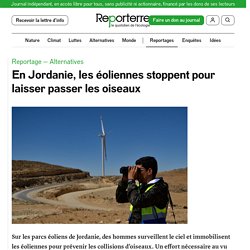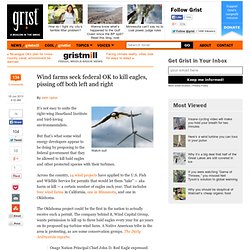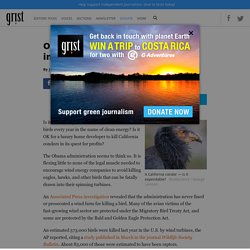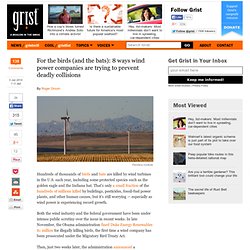

18-20 oct. 2021 En Jordanie, les éoliennes stoppent pour laisser passer les oiseaux. Rajef (Jordanie), reportage Nous sommes à la fin de l’été et tout semble calme dans le parc éolien de Rajef, situé à quelques dizaines de kilomètres de Pétra — la perle touristique de la Jordanie.

Sous un soleil écrasant, les pales d’une quarantaine d’éoliennes tournent sans accroc. Le ciel est limpide quand, soudain, un tourbillon de silhouettes noires emplit l’espace : des milliers de cigognes s’élèvent lentement sous le regard attentif de trois hommes, jumelles aux poings et téléphone en main. Ce sont des « observateurs ». Leur mission : protéger les oiseaux d’une éventuelle collision via le « shutdown on demand » (« arrêt à la demande » ou bridage), qui consiste à mettre à l’arrêt tout ou partie d’un parc éolien à l’approche de certaines espèces. Depuis plus de cinq ans, la Jordanie pilote l’application de cette technique de réduction des dangers des éoliennes pour l’avifaune, encore peu utilisée en Europe.
Autoroute des airs Arrêts « à la demande » La passion des oiseaux. Wind energy company fined $1 million over bird deaths. Wind farms seek federal OK to kill eagles, pissing off both left and right. It’s not easy to unite the right-wing Heartland Institute and bird-loving environmentalists.

But that’s what some wind energy developers appear to be doing by proposing to the federal government that they be allowed to kill bald eagles and other protected species with their turbines. Across the country, 14 wind projects have applied to the U.S. Fish and Wildlife Service for permits that would let them “take” — aka harm or kill — a certain number of eagles each year. That includes four wind farms in California, one in Minnesota, and one in Oklahoma. The Oklahoma project could be the first in the nation to actually receive such a permit. Osage Nation Principal Chief John D. Reuters reports that the Obama administration has been working to loosen wildlife rules to facilitate wind development: The prospect of eagle “take” permits has angered some folks on the left and on the right — and in between.
Of course, conservationists and right wingers don’t actually see eye to eye on this issue. Killing Them Softly: How Wind Turbines Affect Waterfowl Nesting - Wildfowl. Obama administration gives wind industry a pass for killing birds. Is it OK to slaughter hundreds of thousands of birds every year in the name of clean energy?

Is it OK for a luxury home developer to kill California condors in its quest for profits? The Obama administration seems to think so. It is flexing little to none of the legal muscle needed to encourage wind energy companies to avoid killing eagles, hawks, and other birds that can be fatally drawn into their spinning turbines. An Associated Press investigation revealed that the administration has never fined or prosecuted a wind farm for killing a bird. Many of the avian victims of the fast-growing wind sector are protected under the Migratory Bird Treaty Act, and some are protected by the Bald and Golden Eagle Protection Act. An estimated 573,000 birds were killed last year in the U.S. by wind turbines, the AP reported, citing a study published in March in the journal Wildlife Society Bulletin.
From the AP article: For the birds (and the bats): 8 ways wind power companies are trying to prevent deadly collisions. Hundreds of thousands of birds and bats are killed by wind turbines in the U.S. each year, including some protected species such as the golden eagle and the Indiana bat.

That’s only a small fraction of the hundreds of millions killed by buildings, pesticides, fossil-fuel power plants, and other human causes, but it’s still worrying — especially as wind power is experiencing record growth. Both the wind industry and the federal government have been under intense public scrutiny over the issue in recent weeks. In late November, the Obama administration fined Duke Energy Renewables $1 million for illegally killing birds, the first time a wind company has been prosecuted under the Migratory Bird Treaty Act. Then, just two weeks later, the administration announced a controversial new rule that will allow energy companies to get 30-year permits for non-intentional eagle deaths at wind farms.
The pressure is now on for wind energy companies to reduce bird and bat mortality. 1. 2. 3. 4. 5. 6. Recherche et développement. Un exemple de méthode d'étude d'impact avant l'installation d'un parc éolien. Eoliennes : un dispositif unique pour protéger les chauves-souris. Un développement de parcs éoliens compatible avec la faune ? > Eolien.